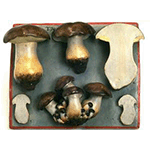Museo di Storia Naturale dell'Accademia dei Fisiocritici ["Accademia dei Fisiocritici" Museum of Natural History]
The Siena Academy of Sciences, known as the "Fisiocritici" (nature's judges), was founded in 1691 in the library of Siena's Hospital of Santa Maria della Scala by Pirro Maria Gabbrielli, professor of Medicine and Botany at the University of Siena. The primary objective of the Academy was that of studying the origins of natural phenomena through experimental verification, and its chosen emblem was the Touchstone, the Lapis Lidius in Latin, to indicate that the institution aimed to make known the truth, just as the Touchstone served to distinguish real from false gold. Moved in 1694 to a room in the Sapienza, seat of the University, after the disastrous earthquake of 1798 it was moved again to the former Camaldolensian Monastery. There the engineer Giuseppe Pianigiani faithfully reconstructed in engraved marble the "camera obscura" sundial that had been installed by Gabrielli in the former seat of the Academy in 1704, called by him the "Fisiocritic heliometer".
Considered one of the most famous cultural societies in Europe, the Academy had among its members such illustrious scientists as Antonio Vallisneri, Giovanni Battista Morgagni, Carl Linnaeus, Leonardo Ximenes, Lazzaro Spallanzani, Felice Fontana, Joseph-Louis Lagrange, Alessandro Volta, George Cuvier, Louis Pasteur and many others. From 1789 to 1815 it was guided by Paolo Mascagni, who conferred on it a more strongly scientific orientation.
The original core of the Academy's nature collections, now kept in the Museum, dates from the mid-eighteenth century. Particularly noteworthy are the "Paolo Mascagni" collection, which includes the books from his personal collection, the scientist's works, his family archive and the anatomical specimens prepared through the technique of injecting metallic mercury into lymphatic vessels; the "Francesco Valenti-Serini" collection, a vast number of terracotta models of edible and poisonous mushrooms, including models and panels showing the mushrooms at the various stages of their development and in section view; the "Francesco Spirito" collection, with anatomical specimens prepared through a petrification process developed in the first half of the 20th century by Francesco Spirito, professor of Obstetrics and Gynaecology.
The zoological collection is remarkable, with specimens of vertebrates and invertebrates, noteworthy among them the Mammals, marine ones in particular, collected from 1970 to the present along the coasts of Tuscany, and the geological collection, consisting mainly of samples from the territory of southern Tuscany, donated in the 18th and 19th centuries.
In the Historical Archives are handwritten documents pertinent to the life and history of the Academy and, more generally, to the history of Sienese science.
****************************
Texts by Anna Toscano
English translation by Catherine Frost
Last update 25/gen/2008




